
- •Preface
- •About This Book
- •Acknowledgments
- •Contents at a Glance
- •Contents
- •Relaxing at the Beach
- •Dressing the Scene
- •Animating Motion
- •Rendering the Final Animation
- •Summary
- •The Interface Elements
- •Using the Menus
- •Using the Toolbars
- •Using the Viewports
- •Using the Command Panel
- •Using the Lower Interface Bar Controls
- •Interacting with the Interface
- •Getting Help
- •Summary
- •Understanding 3D Space
- •Using the Viewport Navigation Controls
- •Configuring the Viewports
- •Working with Viewport Backgrounds
- •Summary
- •Working with Max Scene Files
- •Setting File Preferences
- •Importing and Exporting
- •Referencing External Objects
- •Using the File Utilities
- •Accessing File Information
- •Summary
- •Customizing Modify and Utility Panel Buttons
- •Working with Custom Interfaces
- •Configuring Paths
- •Selecting System Units
- •Setting Preferences
- •Summary
- •Creating Primitive Objects
- •Exploring the Primitive Object Types
- •Summary
- •Selecting Objects
- •Setting Object Properties
- •Hiding and Freezing Objects
- •Using Layers
- •Summary
- •Cloning Objects
- •Understanding Cloning Options
- •Mirroring Objects
- •Cloning over Time
- •Spacing Cloned Objects
- •Creating Arrays of Objects
- •Summary
- •Working with Groups
- •Building Assemblies
- •Building Links between Objects
- •Displaying Links and Hierarchies
- •Working with Linked Objects
- •Summary
- •Using the Schematic View Window
- •Working with Hierarchies
- •Setting Schematic View Preferences
- •Using List Views
- •Summary
- •Working with the Transformation Tools
- •Using Pivot Points
- •Using the Align Commands
- •Using Grids
- •Using Snap Options
- •Summary
- •Exploring the Modifier Stack
- •Exploring Modifier Types
- •Summary
- •Exploring the Modeling Types
- •Working with Subobjects
- •Modeling Helpers
- •Summary
- •Drawing in 2D
- •Editing Splines
- •Using Spline Modifiers
- •Summary
- •Creating Editable Mesh and Poly Objects
- •Editing Mesh Objects
- •Editing Poly Objects
- •Using Mesh Editing Modifiers
- •Summary
- •Introducing Patch Grids
- •Editing Patches
- •Using Modifiers on Patch Objects
- •Summary
- •Creating NURBS Curves and Surfaces
- •Editing NURBS
- •Working with NURBS
- •Summary
- •Morphing Objects
- •Creating Conform Objects
- •Creating a ShapeMerge Object
- •Creating a Terrain Object
- •Using the Mesher Object
- •Working with BlobMesh Objects
- •Creating a Scatter Object
- •Creating Connect Objects
- •Modeling with Boolean Objects
- •Creating a Loft Object
- •Summary
- •Understanding the Various Particle Systems
- •Creating a Particle System
- •Using the Spray and Snow Particle Systems
- •Using the Super Spray Particle System
- •Using the Blizzard Particle System
- •Using the PArray Particle System
- •Using the PCloud Particle System
- •Using Particle System Maps
- •Controlling Particles with Particle Flow
- •Summary
- •Understanding Material Properties
- •Working with the Material Editor
- •Using the Material/Map Browser
- •Using the Material/Map Navigator
- •Summary
- •Using the Standard Material
- •Using Shading Types
- •Accessing Other Parameters
- •Using External Tools
- •Summary
- •Using Compound Materials
- •Using Raytrace Materials
- •Using the Matte/Shadow Material
- •Using the DirectX 9 Shader
- •Applying Multiple Materials
- •Material Modifiers
- •Summary
- •Understanding Maps
- •Understanding Material Map Types
- •Using the Maps Rollout
- •Using the Map Path Utility
- •Using Map Instances
- •Summary
- •Mapping Modifiers
- •Using the Unwrap UVW modifier
- •Summary
- •Working with Cameras
- •Setting Camera Parameters
- •Summary
- •Using the Camera Tracker Utility
- •Summary
- •Using Multi-Pass Cameras
- •Creating Multi-Pass Camera Effects
- •Summary
- •Understanding the Basics of Lighting
- •Getting to Know the Light Types
- •Creating and Positioning Light Objects
- •Viewing a Scene from a Light
- •Altering Light Parameters
- •Working with Photometric Lights
- •Using the Sunlight and Daylight Systems
- •Using Volume Lights
- •Summary
- •Selecting Advanced Lighting
- •Using Local Advanced Lighting Settings
- •Tutorial: Excluding objects from light tracing
- •Summary
- •Understanding Radiosity
- •Using Local and Global Advanced Lighting Settings
- •Working with Advanced Lighting Materials
- •Using Lighting Analysis
- •Summary
- •Using the Time Controls
- •Working with Keys
- •Using the Track Bar
- •Viewing and Editing Key Values
- •Using the Motion Panel
- •Using Ghosting
- •Animating Objects
- •Working with Previews
- •Wiring Parameters
- •Animation Modifiers
- •Summary
- •Understanding Controller Types
- •Assigning Controllers
- •Setting Default Controllers
- •Examining the Various Controllers
- •Summary
- •Working with Expressions in Spinners
- •Understanding the Expression Controller Interface
- •Understanding Expression Elements
- •Using Expression Controllers
- •Summary
- •Learning the Track View Interface
- •Working with Keys
- •Editing Time
- •Editing Curves
- •Filtering Tracks
- •Working with Controllers
- •Synchronizing to a Sound Track
- •Summary
- •Understanding Your Character
- •Building Bodies
- •Summary
- •Building a Bones System
- •Using the Bone Tools
- •Using the Skin Modifier
- •Summary
- •Creating Characters
- •Working with Characters
- •Using Character Animation Techniques
- •Summary
- •Forward versus Inverse Kinematics
- •Creating an Inverse Kinematics System
- •Using the Various Inverse Kinematics Methods
- •Summary
- •Creating and Binding Space Warps
- •Understanding Space Warp Types
- •Combining Particle Systems with Space Warps
- •Summary
- •Understanding Dynamics
- •Using Dynamic Objects
- •Defining Dynamic Material Properties
- •Using Dynamic Space Warps
- •Using the Dynamics Utility
- •Using the Flex Modifier
- •Summary
- •Using reactor
- •Using reactor Collections
- •Creating reactor Objects
- •Calculating and Previewing a Simulation
- •Constraining Objects
- •reactor Troubleshooting
- •Summary
- •Understanding the Max Renderers
- •Previewing with ActiveShade
- •Render Parameters
- •Rendering Preferences
- •Creating VUE Files
- •Using the Rendered Frame Window
- •Using the RAM Player
- •Reviewing the Render Types
- •Using Command-Line Rendering
- •Creating Panoramic Images
- •Getting Printer Help
- •Creating an Environment
- •Summary
- •Creating Atmospheric Effects
- •Using the Fire Effect
- •Using the Fog Effect
- •Summary
- •Using Render Elements
- •Adding Render Effects
- •Creating Lens Effects
- •Using Other Render Effects
- •Summary
- •Using Raytrace Materials
- •Using a Raytrace Map
- •Enabling mental ray
- •Summary
- •Understanding Network Rendering
- •Network Requirements
- •Setting up a Network Rendering System
- •Starting the Network Rendering System
- •Configuring the Network Manager and Servers
- •Logging Errors
- •Using the Monitor
- •Setting up Batch Rendering
- •Summary
- •Compositing with Photoshop
- •Video Editing with Premiere
- •Video Compositing with After Effects
- •Introducing Combustion
- •Using Other Compositing Solutions
- •Summary
- •Completing Post-Production with the Video Post Interface
- •Working with Sequences
- •Adding and Editing Events
- •Working with Ranges
- •Working with Lens Effects Filters
- •Summary
- •What Is MAXScript?
- •MAXScript Tools
- •Setting MAXScript Preferences
- •Types of Scripts
- •Writing Your Own MAXScripts
- •Learning the Visual MAXScript Editor Interface
- •Laying Out a Rollout
- •Summary
- •Working with Plug-Ins
- •Locating Plug-Ins
- •Summary
- •Low-Res Modeling
- •Using Channels
- •Using Vertex Colors
- •Rendering to a Texture
- •Summary
- •Max and Architecture
- •Using AEC Objects
- •Using Architectural materials
- •Summary
- •Tutorial: Creating Icy Geometry with BlobMesh
- •Tutorial: Using Caustic Photons to Create a Disco Ball
- •Summary
- •mental ray Rendering System
- •Particle Flow
- •reactor 2.0
- •Schematic View
- •BlobMesh
- •Spline and Patch Features
- •Import and Export
- •Shell Modifier
- •Vertex Paint and Channel Info
- •Architectural Primitives and Materials
- •Minor Improvements
- •Choosing an Operating System
- •Hardware Requirements
- •Installing 3ds max 6
- •Authorizing the Software
- •Setting the Display Driver
- •Updating Max
- •Moving Max to Another Computer
- •Using Keyboard Shortcuts
- •Using the Hotkey Map
- •Main Interface Shortcuts
- •Dialog Box Shortcuts
- •Miscellaneous Shortcuts
- •System Requirements
- •Using the CDs with Windows
- •What’s on the CDs
- •Troubleshooting
- •Index
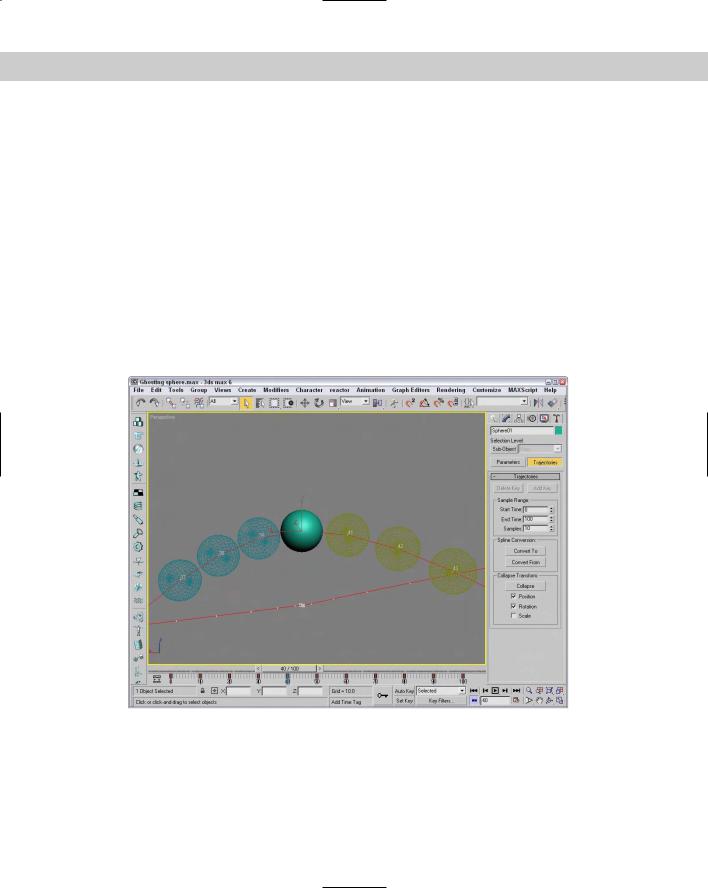
Chapter 30 Animation Basics 745
Using Ghosting
As you’re trying to animate objects, using the ghosting feature can be very helpful. This feature displays a copy of the object being animated before and after its current position. To enable ghosting, choose Views Show Ghosting. This command uses the options set in the Preference Settings dialog box. Access this dialog box by choosing Customize Preferences. In the Viewports panel of this dialog box is a Ghosting section.
You use this Ghosting section to set how many ghosted objects are to appear, whether the ghosted objects appear before, after, or both before and after the current frame, and whether frame numbers should be shown. You can also specify every Nth frame to be displayed. You also have an option to display the ghost object in wireframe (they are displayed as shaded if this option is not enabled) and an option to Show Frame Numbers. Objects before the current frame are colored yellow, and objects after are colored light blue.
Figure 30-10 shows a Sphere object that is animated to travel in a bumpy circle with ghosting enabled. The Preference settings are set to show three ghosting frames at every five frames before and after the current frame. The Trajectory path has also been enabled.
Figure 30-10: Enabling ghosting lets you know where an object is and where it’s going.
Animating Objects
Many different objects in Max can be animated, including geometric objects, cameras, lights, and materials. In this section, we look at several different types of objects and parameters that can be animated.
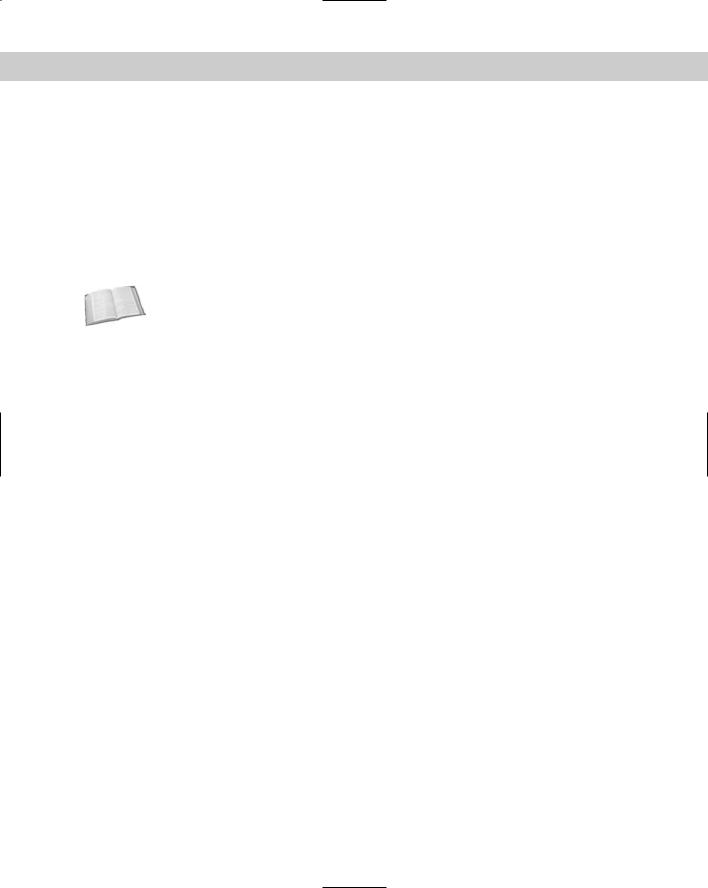
746 Part VII Animation
Animating cameras
You can animate cameras using the standard transform buttons found on the main toolbar. When animating a camera that actually moves in the scene, using a Free camera is best. A Target camera can be pointed by moving its target, but you risk its being flipped over if the target is ever directly above the camera. If you want to use a Target camera, attach both the camera and its target to a Dummy object using the Link button and move the Dummy object.
Two useful constraints when animating cameras are the Path constraint and the Look At constraint. You can find both of these in the Animation Constraints menu. The Path constraint can make a camera follow a spline path, and the Look At constraint can direct the focus of a camera to follow an object as the camera or the object moves through the scene.
Cross- |
For more on constraints, including these two, see Chapter 31, “Animating with Constraints |
Reference |
and Controllers.” |
|
Tutorial: Animating darts hitting a dartboard
As a simple example of animating objects using the Auto Key button, we animate several darts hitting a dartboard.
To animate several darts hitting a dartboard, follow these steps:
1.Open the Dart and dartboard.max file from the Chap 30 directory on the CD-ROM. This file includes a dart and dartboard objects created by Zygote Media.
2.Click the Auto Key button (or press the N key) to enable animation mode. Drag the Time Slider to frame 25, and click the Select and Move button on the main toolbar.
3.Select the first dart in the Left viewport, and drag it to the left until its tip just touches the dartboard.
This step creates a key in the Track Bar for frames 0 and 25.
4.Click the Select and Rotate button on the main toolbar, set the reference coordinate system to Local, and constrain the rotation to the Y axis. Then drag the selected dart in the Front viewport to rotate it about its local Y axis.
This step also sets a key in the Track Bar.
5.Select the second dart, and click the Select and Move button again. Right-click the Time Slider to make the Create Key dialog box appear. Make sure that the check boxes for Position and Rotation are selected, and click OK.
This step creates a key that keeps the second dart from moving before it’s ready.
6.With the second dart still selected, drag the Time Slider to frame 50 and move the dart to the dartboard as shown in Step 3. Then repeat Step 4 to set the rotation key for the second dart.
7.Repeat Steps 3, 4, and 5 for the last two darts.
8.Click the Auto Key button (or press the N key) again to disable animation mode, maximize the Perspective viewport, and click the Play Animation button to see the animation. Figure 30-11 shows the darts as they’re flying toward the dartboard.
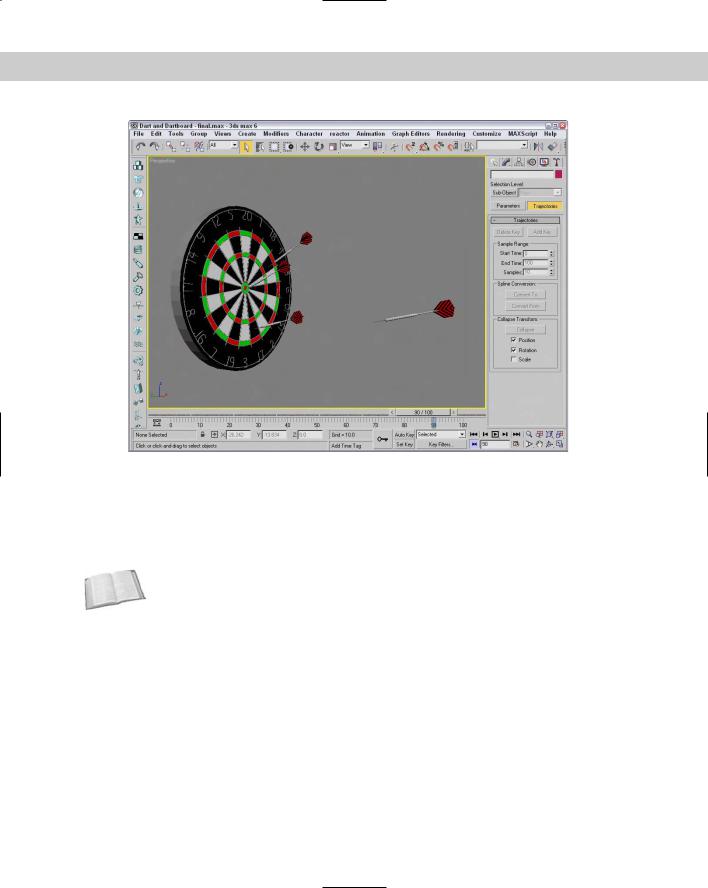
Chapter 30 Animation Basics 747
Figure 30-11: One frame of the dart animation
Animating lights
The process for animating lights includes many of the same techniques as that for animating cameras. For moving lights, use a Free Spot light or attach a Target Spot light to a Dummy object. You can also use the Look At and Path controllers with lights.
Cross- |
If you need to animate the sun at different times in the day, use the Sunlight system, which |
Reference |
is discussed in Chapter 27, “Basic Lighting Techniques.” |
|
To flash lights on and off, enable and disable the On parameter at different frames and assign a Step Tangent. To dim lights, just alter the Multiplier value over several frames.
Animating materials
Materials can be animated if their properties are altered while the Auto Key button is active. Max interpolates between the values as the animation progresses. The material must be consistent for the entire animation — you cannot change materials at different keys, you can only alter the existing materials parameters.
If you want to change materials as the animation progresses, you can use a material that combines multiple materials, such as the Blend material. This material includes a Mix Amount
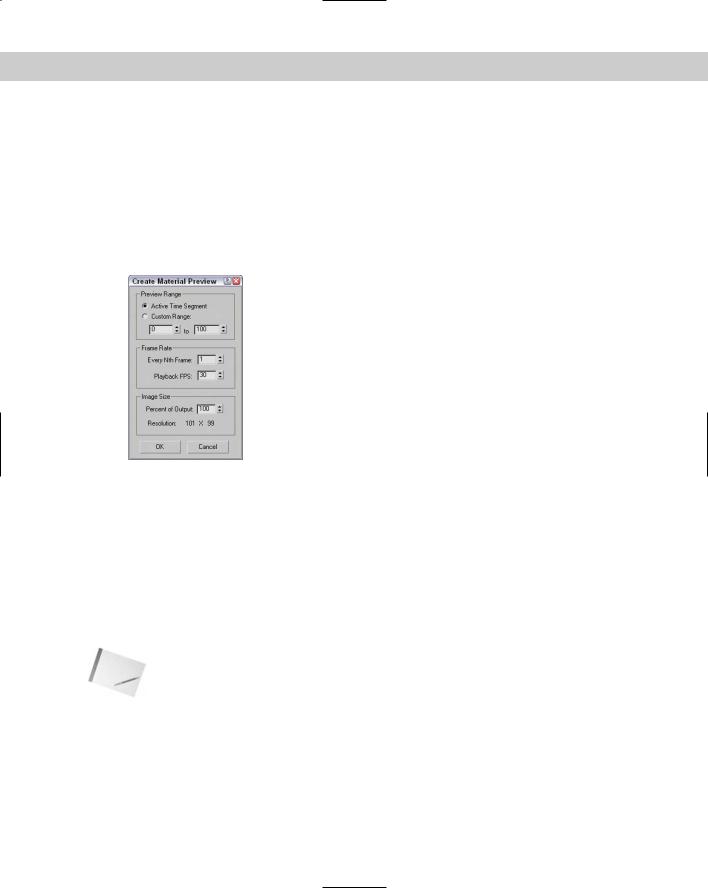
748 Part VII Animation
value that can change at different keyframes. The next tutorial shows how to use the Blend material in this manner.
Several maps include a Phase value, including all maps that have a Noise rollout. This value provides the means to animate the map. For example, using a Noise map and changing the Phase value over many keys animates the noise effect.
A useful way to view animated materials is to click the Make Preview button (the sixth button from the top) to open the Create Material Preview dialog box, shown in Figure 30-12. Select the Active Time Segment option, and click OK. The material renders every frame and automatically opens and plays the material preview.
Figure 30-12: The Create Material Preview dialog box can render the entire range of frames or a select number of frames.
Tutorial: Dimming lights
Occasionally, you’ll want to change materials in a scene to gradually alter it in some way, such as dimming a light. You can easily accomplish this task with the Blend material.
To create a light that dims with time, follow these steps:
1.Open the Dimming light.max file from the Chap 30 directory on the CD-ROM. This file contains a simple lamp object with a sphere to represent a light bulb.
2.Open the Material Editor by pressing the M key, and select the first sample slot. Then click the Type button, and select the Blend material from the Material/Map Browser. Give the material the name Dimming Light.
Note When using composite materials, a dialog box appears asking whether you want to discard the old material or keep it as a submaterial. If you choose to keep it, the current material in the sample slot becomes one of the maps for the composite material.
3.Click the Material 1 button, and give the material the name Light On. Set the Diffuse color to yellow and the Self-Illumination to yellow. Then click the Go Forward to Sibling button.

Chapter 30 Animation Basics 749
Note |
Composite materials such as Blend include several submaterials. When one of these subma- |
|
terials is selected, you can move quickly to the other submaterials by clicking the Go Forward |
|
to Sibling button. To access the root material, click the Go to Parent button. |
4.Name the second material Light Off, and select a gray Diffuse color. Then click the Go to Parent button to return to the Blend material.
5.With the Time Slider at frame 0, click the Auto Key button (or press the N key). Then drag the Time Slider to frame 100, and change the Mix Amount to 100. Click the Auto Key button again to deactivate it. The material changes gradually from the “Light On” material to the “Light Off” material. By dragging the Time Slider, you can see the material in the sample slot change.
6.Select the light bulb object, and click the Assign Material to Selection button to assign the material to the bulb object.
Figure 30-13 shows a simple lamp object with a dimming sphere in its center. The actual dimming effect isn’t visible in the viewport — only when the image is rendered.
Using IFL files
Anywhere you can load a bitmap map, you can also load an animation file such as a Microsoft Video (AVI) or a FLC file. Another way to create animated material is with Image File List (IFL) files.
IFL files are text files that list which images should appear and for which frames. You save them with the .IFL extension and load them using the Bitmap map. To create an IFL file, open a text editor and type the name of the image followed by the number of frames for which it should appear. Be sure to include a space between the name and the number of frames. The images are displayed in the order they are listed and repeated until all frames have been displayed. Once applied, the IFL file is visible in the sample slot if you drag the Time slider, or you can create a material preview.
Note You can also use the * and ? wildcard characters within an IFL file. For example, flyby* includes any image file that begins with “flyby,” and flyby? includes any image file that begins with “flyby” and has one additional character.
Generating IFL files with the IFL Manager Utility
If you don’t want to create text files by yourself, you can use the IFL Manager Utility to generate IFL files for you. To use this utility, open the Utilities panel and click the More button. Then select the IFL Manager Utility, and click OK.
In the IFL Manager rollout, shown in Figure 30-14, the Select button opens a File dialog box where you can select a sequential list of images to include in an IFL file. After you select a list of images, you can specify the Start and End images. You can cause the images to be displayed in reverse by placing a greater number in the Start field than is in the End field. The Every Nth field can specify to use every Nth image. You use the Multiplier field to specify in how many frames each image should appear.
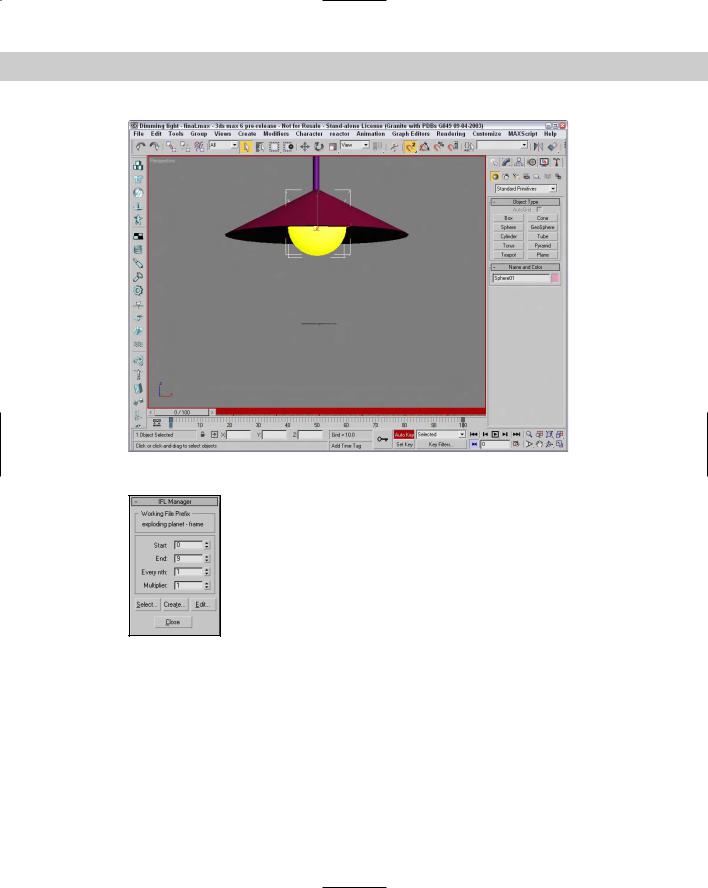
750 Part VII Animation
Figure 30-13: This lamp object dims as the animation proceeds.
Figure 30-14: IFL Manager utility can help to create IFL files.
The Create button opens a File dialog box where you can save the IFL file. The Edit button opens an IFL text file in the system’s default text editor for editing.
Tutorial: What’s on TV?
Animated files such as AVI and FLC can be opened and mapped to an object to animate the texture, but you can also use IFL files.
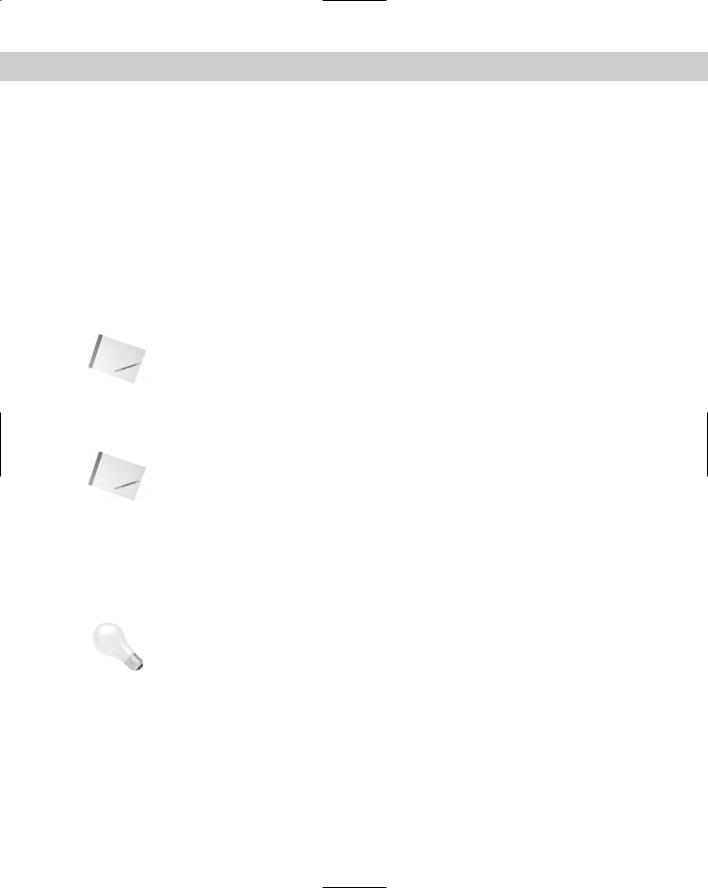
Chapter 30 Animation Basics 751
Note
Note
Tip
To create an IFL file that will be mapped on the front of a television model, follow these steps:
1.Open the Windows standard Notepad text editor, and type the following:
; these frames will be positioned on a television screen. static.tif 20
Exploding planet - frame 10.tif 2Telev Exploding planet - frame 15.tif 2 Exploding planet - frame 20.tif 2 Exploding planet - frame 25.tif 2 Exploding planet - frame 30.tif 2 Exploding planet - frame 35.tif 2 Exploding planet - frame 40.tif 2 Exploding planet - frame 45.tif 2 Exploding planet - frame 50.tif 2 Exploding planet - frame 55.tif 2 static.tif 60
The first line of text is referred to as a comment line. You enter comments into the IFL file by starting the line with a semicolon (;) character.
2.Save the file as tv.ifl. Make sure that your text editor doesn’t add the extension .TXT on the end of the file.
You can check your file with the one I created, which you can find in the Chap 30 directory on the CD-ROM.
The IFL file as described earlier looks for the image files in the same directory as the IFL file. Make sure that the images are included in this directory.
3.Open the Television — IFL File.max file from the Chap 30 directory on the CD-ROM. This file includes a television model created by Zygote Media.
4.Select the television front screen object, open the Material Editor, and select the first sample slot. Name the material Television Screen. Click the map button to the right of the Diffuse color swatch. Double-click the Bitmap map. In the File dialog box, locate the tv.ifl file and click OK. Then click the Assign Material to Selection button to apply the material to the screen.
To see the map in the viewport, click the Show Map in Viewport button. This button makes the frames of the IFL file visible in the viewport.
5.Because the screen object is a mesh object, you need to use the UVW Map modifier to create some mapping coordinates for the map. Open the Modify panel, and click the UVW Map button. Set the mapping option to Planar. Then click the Sub-Object button, and transform the planar gizmo until it covers the screen.
6.Click the Play button (/) to see the final animation.
Figure 30-15 shows one rendered frame of the television with the IFL file applied.
